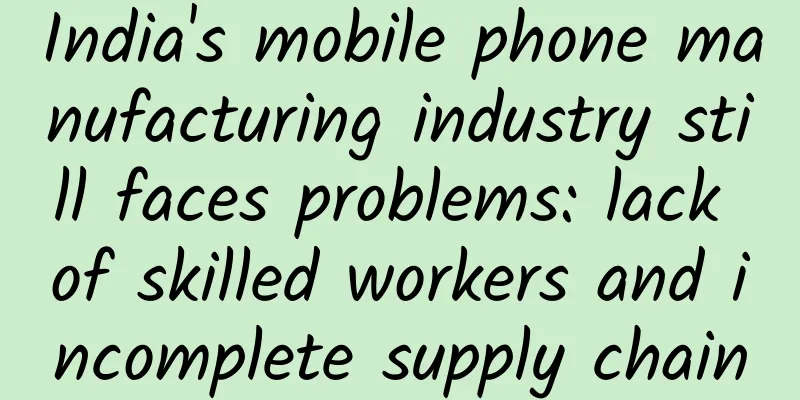India's mobile phone manufacturing industry still faces problems: lack of skilled workers and incomplete supply chain

|
India’s dream of becoming a smartphone manufacturing powerhouse is shattering due to a lack of skilled workers and component supply chains, as well as a complex tax system, industry executives said. Indian Prime Minister Narendra Modi is vigorously promoting the development of manufacturing and has put forward the slogan of "Make in India" to boost the sluggish economy and create millions of jobs. One of the plans that has attracted widespread attention is to make Apple's iPhone "made in India". But three years later, India still can only assemble mobile phones using imported components . Although contract manufacturers such as Foxconn and Wistron have established production bases in India, one of the world's fastest-growing smartphone markets, almost all high-end components such as chips and cameras are not produced in India. Foxconn's plan to build an electronic components factory in Maharashtra, India has come to a halt. While phones are assembled in India, taxes on imported phones generally limit components made there to earpieces and chargers, which account for about 5 percent of a phone’s cost, according to market research firm Counterpoint. An executive of a Chinese mobile phone manufacturer said, " Don't think that India is suitable for making mobile phones. I just need to assemble mobile phones there because tariffs are low and I can import components and assemble them in India. " The executive declined to be named for fear of a disruption to business. Other mobile phone manufacturers listed the reasons for not making mobile phones in India, including the lack of skilled engineers and supporting component manufacturers. They also said that the tax dispute between India and foreign mobile phone manufacturers such as Nokia also affected their plans to produce mobile phones in India. Another industry source said India's sales tax also faces challenges, such as a lengthy refund process that delays payments to suppliers. "To start manufacturing in India, we need government help," said Neeraj Sharma, India head of Chinese chipmaker Spreadtrum Communications. "This is a must because without government help, nothing can be done." However, India needs more advanced technologies, such as surface mount technology (mounting components directly on circuit boards), to build a supply chain. In addition, companies will not develop technology in India, Sarma said, "to do design work in India, we need to have strong local partners." The Indian government said it has formulated a phased plan for mobile phone manufacturing, gradually increasing the localization rate each year. Aruna Sundarajan, India's Minister of Telecommunications, told the media, "We will first assemble mobile phones and plan to gradually move up the industrial chain. Many investors have shown interest." According to the Indian government's "Phase-based Manufacturing Plan", manufacturers will start manufacturing mobile phone chargers and batteries in India from 2016 and start producing high-end components in 2020. Sundararajan said the government was also working to give investors "a reasonable level of certainty" while dealing with disruption to the industry. But for phone makers accustomed to predictability in China, India still has work to do, industry executives warn. A senior executive at a Chinese smartphone maker in India said some Chinese manufacturers were unhappy about labor unrest, including a strike at a factory belonging to Oppo earlier this year. “Labor laws are equivalent to taxes, and India has done little to build a component ecosystem and logistics. Transportation is still a big problem. No one is investing in the skilled workers needed to make phones,” the executive said. As a winner of Toutiao's Qingyun Plan and Baijiahao's Bai+ Plan, the 2019 Baidu Digital Author of the Year, the Baijiahao's Most Popular Author in the Technology Field, the 2019 Sogou Technology and Culture Author, and the 2021 Baijiahao Quarterly Influential Creator, he has won many awards, including the 2013 Sohu Best Industry Media Person, the 2015 China New Media Entrepreneurship Competition Beijing Third Place, the 2015 Guangmang Experience Award, the 2015 China New Media Entrepreneurship Competition Finals Third Place, and the 2018 Baidu Dynamic Annual Powerful Celebrity. |
<<: Cadillac Minister Feng Dan calls for anti-counterfeiting on Pinduoduo: refurbished cars, fakes
>>: NIO receives RMB 7 billion investment and moves its headquarters to Hefei
Recommend
I get shocked when I disagree with something. Why does static electricity always come to me?
Audit expert: Zhou Hongzhi Senior Experimentalist...
Can’t drink water before a physical examination? This “physical examination notice” is not only useless, but also harmful!
As far as the current situation is concerned, fas...
The amazing gravitational lens effect allows you to see the real curvature of space-time. Is this evidence reliable?
Gravitational lensing is a conclusion and predict...
Ku Yixuan丨Do you want to "live in the present" with only 5 minutes of memory?
"Imagine if we didn't have a hippocampus...
Download the full version of the package dating method on Baidu Cloud
Introduction to Package Date This course is a cou...
Others with 0 followers can easily get 100,000 likes on Douyin. What is Douyin’s recommendation algorithm?
Tik Tok 's decentralized algorithm gives ever...
2021 Beijing's "Most Beautiful Science and Technology Worker" | Shi Yahui: A "veteran" in the field of remote sensing
As a leader in remote sensing professional techno...
New food regulations are coming! It concerns everyone. Read the labels like this when buying things in the future →
On March 27, 2025, the National Health Commission...
How to start promotion from scratch?
From Internet to Mobile Internet At a time when s...
APP operation: Can the revenue from application push be increased by 400%?
Push is the most cost-effective and direct market...
Special: How many stunning mountains and rivers are there in China?
How many colors does the Chinese land have? That&...
The amazing oracle bone inscriptions: He was the first person to evolve oracle bone studies from philology to historiography
Wang Guowei Wang Guowei's work "New Evid...
4K becomes the standard for TVs, but there are differences in standard names
4K TV is a TV with a physical screen resolution o...
Do you understand 50% of alloc and init?
Preface This is a note that records my analysis a...









